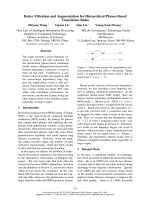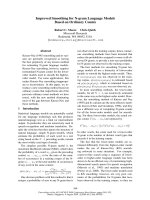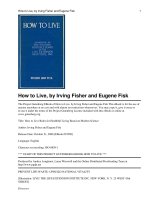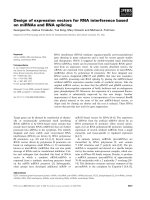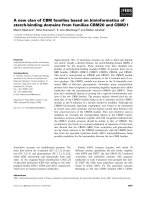Efficient retrieval and categorization for 3d models based on bag of words approach
Bạn đang xem bản rút gọn của tài liệu. Xem và tải ngay bản đầy đủ của tài liệu tại đây (4.22 MB, 126 trang )
EFFICIENT RETRIEVAL AND CATEGORIZATION FOR
3D MODELS BASED ON BAG-OF-WORDS APPROACH
WANG YAN
NATIONAL UNIVERSITY OF SINGAPORE
2013
EFFICIENT RETRIEVAL AND CATEGORIZATION FOR 3D
MODELS BASED ON BAG-OF-WORDS APPROACH
WANG YAN
(B.Eng)
A THESIS SUBMITTED
FOR THE DEGREE OF DOCTOR OF PHILOSOPHY
DEPARTMENT OF MECHANICAL ENGINEERING
NATIONAL UNIVERSITY OF SINGAPORE
2013
i
ACKNOWLEDGEMENTS
First of all, I would like to the most sincere gratitude to my supervisors Prof. Jerry Fuh
Ying Hsi and Prof. Lu Wen Feng, not only for their enormous support and guidance,
but also for their kindly encouragement during times of difficulties along with my
doctoral studies. This thesis cannot be completed without their timely feedback and
careful revision.
I would also like to thank Prof. Wong Yoke San for his intensive discussions and many
valuable suggestions throughout group meetings together. Many thanks also go to Prof.
Cheong Loong Fah from the Department of Electrical and Computer Engineering, for
his many useful suggestions, critical comments and encouragement during my second
year of PhD study. I wish to thank Prof. Zhang Yunfeng for his comments and
suggestions during my qualifying examination.
I would like to also thank the National University of Singapore for providing the
research scholarship to support my doctoral studies.
My gratitude also goes to all the members in the labs of manufacturing group,
especially Dr. Zhu Kunpeng, Dr. Wang Jinling, Dr. Wang Yifa, Dr. Li Min, Dr. Zheng
Fei, Dr. Wang Xue, Ms. Zhong Xin and many others, for their encouragement, support
Acknowledgements
ii
and creating a friendly environment. I wish thank all of my friends for their support
and care.
Last, but not least, I would like to express my hearty gratitude to my parents and my
husband for their love and continuous support and understanding.
Table of Contents
iii
TableofContents
ACKNOWLEDGEMENTS i
SUMMARY vi
LIST OF FIGURES ix
LIST OF TABLES xi
Chapter 1 INTRODUCTION 1
1.1 Background 1
1.2 Research Motivation 2
1.3 Research Objectives 4
1.4 Organization of this Thesis 6
Chapter 2 LITERATURE REVIEW 7
2.1 Introduction 7
2.2 3D Model Retrieval based on Visual Similarity 10
2.3 3D Model Retrieval using Bag-of-Words Model 14
2.4 3D Model Categorization 21
2.5 Summary 22
Chapter 3 FRAMEWORK FOR RETRIEVAL AND CATEGORIZATION OF 3D MODELS
USING BAG-OF-WORDS MODEL REPRESENTATION 24
3.1 Overview of this Research 24
3.2 Pose Alignment and Depth Image Extraction 27
3.2.1 Pose Alignment 27
3.2.2 Depth Image Extraction 30
3.3 Bag-of-Words Model Representation 32
3.3.1 Codebook Generation and Model Representation 32
3.3.2 Similarity Distance Comparison 33
3.4 Evaluation Measures for 3D Model Retrieval 34
3.5 Experimental Datasets 36
3.5.1 Purdue Engineering Shape Benchmark 36
3.5.2 Modified CAD dataset 38
3.5.3 NIST Generic Shape Benchmark 38
3.5.4 SHREC 2009 Partial Dataset 39
3.6 3D Model Retrieval Case Study 40
Table of Contents
iv
3.7 Summary 41
Chapter 4 MODIFIED DENSE SAMPLING AND MULTI-SCALE DENSE SAMPLING OF
LOCAL FEATURES USING SIFT DESCRIPTION FOR 3D MODEL RETRIEVAL 43
4.1 Introduction 43
4.2 Scale Invariant Feature Transform (SIFT) Algorithm for Feature Detection and Description45
4.3 Modified Dense Sampling and PHOW Sampling for Feature Extraction 47
4.5 Results and Discussions 51
4.4.1 Retrieval Results on ESB 52
4.4.2 Retrieval Results on NIST Generic Shape Benchmark 58
4.4.3 Retrieval Results on SHREC 2009 Partial Dataset 62
4.5 Summary 65
Chapter 5 REGION-BASED FEATURE DETECTION AND REPRESENTATION FOR 3D
MODEL RETRIEVAL 66
5.1 Introduction 66
5.2 Region Speeded-Up Robust Feature (RSURF) and Histogram of Oriented Gradients (HOG)
Descriptor 67
5.3 Results and Discussions 73
5.4 Summary 81
Chapter 6 LARGE-SCALE 3D MODEL CATEGORIZATION USING MULTI-CLASS SVM
WITH LINEARLY APPROXIMATED KERNEL 82
6.1 Introduction 82
6.2 3D Model Categorization with Multi-class Kernel SVM 83
6.2.1 Bag-of-Words Representation for Categorization of 3D Models 83
6.2.2 Non-linear Kernel SVM Approximated by Linear Homogeneous Feature Maps 84
6.2.3 Multi-class SVM categorization 87
6.3 Results and Discussions 88
6.3.1 Classification Results on the NIST Generic Shape Benchmark 90
6.3.2 Classification Results on the Modified CAD Dataset 92
6.4 Summary 95
Chapter 7 CONCLUSIONS AND RECOMMENDATIONS FOR FUTURE WORK 96
7.1 Conclusions 96
7.2 Recommendations for Future Works 99
7.2.1 Extension for an Improved Bag-of-Words Representation 99
7.2.2 Extension for an Incremental Bag-of-Words Learning for Classification 100
PUBLICATIONS 102
Table of Contents
v
REFERENCES 103
Appendix A Lists of the Modified CAD Dataset 108
Summary
vi
SUMMARY
Efficient retrieval and categorization of 3D models are in urgent need due to the rapid
proliferation of 3-Dimensional (3D) digital models. Recently, bag-of-words approach
based on the visual similarity for 3D model retrieval has received a lot of attention for
its superior performance and scalability to various input formats. It represents 3D
model as histogram of visual words according to a codebook generated from local
features extracted from 2D depth images. However, existing salient feature extraction
methods not only are time-consuming, but also require large computation and storage
capacity. Besides, very little research work has addressed 3D model categorization
problem compared to large amount of work for the 3D model retrieval tasks. The
categorization of 3D models is of great importance because when the database is huge,
it is impossible to compare the query example with all target models, so there is a need
for a mechanism to classify the query models into categories. This research aims at
achieving two main objectives. The first objective is to develop more discriminative
but computationally less expensive feature extraction methods. The second objective is
to develop a 3D model categorization system which is very little addressed in the past.
Both of the two objectives are achieved based on the bag-of-words framework.
Firstly, a modified dense sampling and multi-scale dense (MSD) sampling strategy of
local salient features are proposed to extract features from depth images of 3D models.
Summary
vii
Dense sampling is to extract features on uniformly distributed grids and MSD
sampling is to extract features at multiple scales on the same grids as dense sampling.
The proposed sampling strategies extract local features over the full range of the depth
images rendered from the 3D model and therefore more suitable for the 3D model
description. With a flat window to substitute circular Gaussian window, the feature
extraction speed for the proposed sampling strategies are in an order of magnitude
faster than the original Scale Invariant Feature Transform (SIFT) detection. In
combination with bag-of-words models, the proposed sampling strategies have shown
superior performance over the original salient SIFT sampling.
Secondly, two region feature descriptors Region Speeded-Up Robust Features (RSURF)
and Histogram of Oriented Gradients (HOG) features are proposed for 3D model
description. The proposed RSURF and HOG features extract features on uniform grids
over a local region. As they extract features with a pre-assumed scale and location,
the proposed region-based feature detections are much faster and of lower dimension
than the salient point detection. The region size, number of orientation bins and
coarse spatial binning will influence the descriptiveness and distinctness of the
region-based feature descriptor together. The proposed region feature descriptors are
used as inputs for bag-of-words model and show a much better accuracy than salient
feature description for the 3D model retrieval tasks.
Thirdly, a 3D model categorization scheme based on the bag-of-words representation
Summary
viii
is proposed using kernelized multi-class SVM for classification. The chi-square kernel
and histogram intersection kernel approximated by linear homogeneous map are
adopted as they are inherently suitable for the histogram-based shape representation.
The linearly approximated kernel SVM not only show significant improvement than
the original SVM, but are also very efficient to compute. Example of the proposed3D
model categorization system will be given for classification of query examples on
public shape benchmark.
List of Figures
ix
LIST OF FIGURES
Figure 3.1 Overview of Retrieval and Categorization of 3D Models based on Bag-of-words
Representation. 25
Figure 3.2 Procedures to compute bag-of-words representation for 3D models. 26
Figure 3.3 6-view camera positions with respect to the object. 31
Figure 3.4 Examples of CAD models from ESB dataset. 37
Figure 3.5 Partial and Range query models for SHREC 09 Partial Dataset. 40
Figure 4.1 Flow chart of sampling strategies of local features for bag-of-words model
representation. 44
Figure 4.2 SIFT descriptor of 4×4 regions and 8 orientations in each region [43]. 46
Figure 4.3 (a) SIFT features extracted from depth image of CAD part model, (b)
Corresponding features, (c) SIFT features extracted from range image of 3D flying bird
model, (d) Corresponding features. 47
Figure 4.9 Influence of distance metric for original SIFT sampling. 56
Figure 4.10 Retrieval examples of sampling methods: (a) original SIFT sampling, (b) modified
dense sampling, and (c) MSD sampling. 56
Figure 4.11 Retrieval accuracy using SIFT, modified dense and MSD sampling. 57
Figure 4.12 Influence of codebook size for 6-view SIFT sampling. 59
Figure 4.13 Influence of codebook size for 6-view modified dense sampling. 60
Figure 4.14 Influence of codebook size for 6-view MSD sampling. 60
Figure 4.15 Overall comparison of precision-recall results for 6-view SIFT sampling, modified
dense sampling and MSD sampling. 61
Figure 4.16 NN, FT, ST, E-measure and DCG measures for 6-view SIFT sampling, modified
dense sampling and MSD sampling. 61
Figure 4.17 DCG measures for 6-view SIFT sampling, modified dense sampling and MSD
sampling on SHREC 2009 Partial Dataset. 63
Figure 4.18 Overall comparison of precision-recall results for 6-view SIFT sampling, dense
sampling and MSD sampling with optimal codebook size. 64
Figure 5.1 Haar wavelet responses for four patterns of image intensity changes [83]. 69
Figure 5.2 Illustration of DSURF feature representation based on Haar wavelet responses of a
sub-region centered at the interest point. 70
Figure 5.3 Integral images makes the computation of summation of image gradients within the
region ACDB is simple as subtracting the integral value at point B and C from point D,
and plus the value at point A [84]. 71
Figure 5.4 Convolution of depth image with 1D mask (-1, 0, 1). 72
Figure 5.5 DCG of RSURF features on modified CAD dataset for different codebook size K.
76
Figure 5.6 DCG of RSURF features on NIST generic shape benchmark for different codebook
size K. 77
List of Figures
x
Figure 5.7 DCG of HOG features on modified CAD dataset for different codebook size K. 78
Figure 5.8 DCG of HOG features on NIST generic shape benchmark for different codebook
size K. 78
Figure 5.9 Precision recall curve for proposed region-based RSURF and HOG features
compared to salient features SIFT and SURF on modified CAD dataset. 79
Figure 5.10 Precision recall curve for proposed region-based RSURF and HOG features
compared to salient features SIFT and SURF on NIST generic shape benchmark. 80
Figure 6.1 Categorization procedures of 3D models using bag-of-words representation. 84
Figure 6.2 Illustration of the multi-class classification problem [71]. 87
Figure 6.3 Convergence of SVM energy for training 89
List of Tables
xi
LIST OF TABLES
Table 3.1 List of 40 types of models for SHREC generic shape benchmark 39
Table 4.1 Feature Extraction Time (s) 53
Table 4.2 NN, FT, DCG, ST, E-measure, and MAP for 6-view SIFT sampling, dense sampling
and MSD sampling with optimal codebook size. 63
Table 5.1 RSURF feature with different region size and number of sub-regions 74
Table 5.2 Feature extraction time (s) for RSURF vs. SURF feature detection 75
Table 5.3 Feature extraction time (s) for HOG feature detection 75
Table 5.4 Other evaluation measures for proposed features vs. SIFT and SURF on modified
CAD dataset 80
Table 5.5 Other evaluation measures for proposed features vs. SIFT and SURF on 81
Table 6.1 Classification accuracy of SVM without kernel for different regularization
parameters C 90
Table 6.2 Classification accuracy of histogram intersection kernel for different regularization
parameter C and feature dimension. 91
Table 6.3 Classification accuracy of Chi-square kernel for different regularization parameter C
and feature dimension. 91
Table 6.4 Overall comparisons for optimal configuration for no kernel, HI and chi2 kernel 92
Table 6.5 Classification accuracy of SVM without kernel for different regularization
parameters C 93
Table 6.6 Classification accuracy of histogram intersection kernel for different regularization
parameter C and feature dimension. 94
Table 6.7 Classification accuracy of Chi-square kernel for different regularization parameter C
and feature dimension. 94
Table 6.8 Overall comparisons for optimal configuration for no kernel, HI and chi2 kernel 95
Chapter 1
1
Chapter 1 INTRODUCTION
1.1 Background
The number of 3-Dimensional (3D) digital models has been rapidly growing due to the
advancement in fields of 3D data acquisition, geometric modeling and visualization. A
large number of 3D models are heavily involved in various applications such as
augmented reality [1], Computer-Aided Design (CAD) [2], cultural heritage [3] and etc.
With the explosion of 3D models both at Internet and in domain specific databases, there
is an urgent need for automatic reuse and management of these models. One challenging
issue is to develop an efficient and effective retrieval and categorization scheme to find
similar models. Automatic retrieval and categorization of 3D models will not only
facilitate the reuse of existing digital contents, but also save a lot of time and human
efforts to create new models and save costs for design and development.
Content-based 3D model similarity search is to use the 3D model itself as query to match
with existing models in a dataset. The similarity of 3D model defined in this thesis is
purely based on shape, although similarity in other forms, e.g. functional similarity, is
also of interest for different applications. In the content-based 3D model similarity
search, both of the query and target models are represented as shape descriptors
computed automatically such that similarity distance between similar models is small in
the high-dimensional feature space. The shape descriptor is required to be both
representative and discriminative in order to better characterize the 3D models for the
Chapter 1
2
similar class and differentiate the models from different classes.
When the number of target models is small, retrieval can be achieved by one-to-one
comparison between query model and target models. However, when the amount of
target models hits a large number, one-to-one comparison becomes unaffordable.
Therefore, one-to-class comparison scheme is needed which could reduce the number of
comparisons only related to the number of categories of existing models. In this thesis,
the one-to-one comparison scenario is named as 3D model retrieval and the one-to-class
comparison procedure is called 3D model categorization. The input format of 3D
models in this thesis is polygonal mesh, however, the methods proposed could be easily
extended to any format of object, including 2D sketches, range scans, point clouds etc.
1.2 Research Motivation
Visual similarity based methods have received appealing retrieval accuracy than other
methods for 3D model retrieval tasks. Among them
, bag-of-words methods are most
attractive not only because of their retrieval accuracy, but also of less storage space
compared with other view-based methods. This is because only the codebook and
histogram of visual
words are kept without the details of descriptors for each model after
the codebook generation. Due to these advantages, this thesis employs the bag-of-words
representation of 3D models. However, there are two limitations to be overcome for
existing approaches of bag-of-words representation of 3D models in order to develop
efficient algorithms to search for similar 3D models in a large-scale dataset in this thesis.
Chapter 1
3
Firstly, local salient features, such as Scale Invariant Feature Transform (SIFT) features,
are often extracted for further shape description. These scale and rotation invariant salient
features are often detected along corners and sharp changes. They might be more suitable
for tasks like object recognition, where a number of notable features are extracted to build
correspondence between two models. However, salient features often do not cover the
whole content of the views of a 3D model, thus not descriptive enough for the
representation of the 3D models.
Therefore, there is a need to develop new feature
descriptors which are more representative and discriminative than the previously
proposed salient feature descriptors.
Secondly, when the amount of 3D models grows large to a certain extent, there are at
least two practical issues to be considered for the 3D model similarity comparison.
One is regarding the computation cost and storage. Although SIFT features are very
descriptive in terms of saliency, it is of very high dimension at 128. Some work
proposed to use 42 views of depth images, and extract around 1k features per image,
the storage requirement becomes unaffordable. Therefore, there is a need to develop
some feature detection and description methods, which not only need less storage
space, but also more representative than the salient features. Another issue is the
affordable computational expense for the 3D model comparison. Existing one-to-one
comparison of models is too time consuming, and sometimes not practical for
large-scale problems. Hence, a scalable system for large-scale 3D model comparison
Chapter 1
4
system needs to be devised.
1.3 Research Objectives
From the above research motivation in Section 1.2, the objectives of this research are
as follows:
To develop feature sampling strategies which are descriptive enough for
bag-of-words representation of 3D model. The sampled features should represent
the 3D model by covering the full content of 3D models. Feature sampling
parameters, such as scales and sampling step, will be investigated to find the
optimal configurations for higher retrieval accuracy. The proposed feature
sampling strategies should also compute the features in a much faster fashion.
To develop two region-based feature descriptors which not only are compact in
representation, but also simple and fast to compute. The Region-SURF (RSURF)
feature is to use the SURF-like descriptor sum Haar wavelet responses over local
image regions for shape representation. The Histogram of Oriented Gradients
computes the derivative of a depth image and votes the gradients into orientation
bins.
To develop an algorithm for categorization of large-scale 3D models. A multi-class
Chapter 1
5
Support Vector Machines (SVM) will be exploited for the categorization scheme.
This learning-by-example approach obtain classifiers from existing models and
assign a query example to a class of similar models without explicit comparison
with all models in a dataset. As the 3D models are represented using the
bag-of-words model, efficient non-linear kernels, such as the histogram
intersection kernel and chi-square kernel that are suitable for the histogram-based
data, can be incorporated with the SVM. The comparisons between the query
model and target models are reduced from the total number of target models to the
number of classes of the target models.
The proposed work of this thesis may have significant impacts for large-scale similarity
comparison of 3D models. The proposed feature detection methods are not only simple
and fast to compute than the salient features, but also more representative and
discriminative. They require less storage space and computational power than the SIFT
feature detection, and therefore more affordable for the generation of codebooks using
K-means clustering. The proposed 3D model categorization system makes the
large-scale comparison of 3D models practical. It may potentially handle thousands of
3D models and large number of categories thanks to the indirect one-to-class
comparison and bridge the gap between single 3D model recognition and generic
recognition. The proposed work has accommodated the needs of managing 3D models
with a rapid growing amount.
Chapter 1
6
1.4 Organization of this Thesis
This chapter presents the background and motivations of this research. A
comprehensive literature review for content-based 3D model retrieval and
categorization is given in Chapter 2. Chapter 3 outlines the framework of this thesis.
The procedures of using bag-of-words approach to represent 3D models are also
presented. Standard evaluation measures and four public available datasets for 3D
model retrieval are also introduced in chapter 3. In Chapter 4, the modified dense
sampling and multi-scale dense sampling of local features using SIFT description are
proposed to incorporate with bag-of-words representation to improve the retrieval
efficiency of 3D models. Chapter 5 proposes two region based descriptors, which are
not only simpler in representation, but are also more discriminative for bag-of-words
model based 3D model retrieval. In chapter 6, a multi-class SVM 3D model
categorization system is proposed for the matching of large-scale 3D models. The
histogram intersection kernel and chi-square kernel approximated with linear
homogeneous maps are combined with the multi-class SVM have showed to improve
the classification accuracy. The last chapter concludes this thesis and proposed
recommendations for future work.
Chapter 2
7
Chapter 2 LITERATURE REVIEW
2.1 Introduction
Recent advancements in techniques for modeling, digitizing and visualizing 3D models
have led to an explosion in the number of available 3D models on the Internet and in
domain-specific databases. Therefore, it is highly desirable to develop 3D model matching
and retrieval algorithms to automatically annotate, recognize and classify 3D models in
large-scale databases. In recent two decades, researchers in field of computer graphics and
vision, geometrical modeling and pattern recognition, have conglomerated and dedicated
enormous efforts to develop effective and efficient similarity search and retrieval
algorithms. Several literature surveys can be found in [4-7]. According to the surveys, the
existing 3D model retrieval approaches can be roughly categorized into four categories:
statistical-based, spatial map-based, topology-based and view-based methods.
The statistical-based methods extract geometrical information of the object and then bin
the measurements into histogram representation. These kinds of methods are generally
easy to implement but not discriminative enough. Horn [8] first introduced the extended
Gaussian Images to map the orientations of surface normal onto a Gaussian sphere and
vote each triangle based on the normal direction. Other geometric measures, e.g., normal
distance of the surface points to the object origin [9], are further investigated. Ankerst et al.
Chapter 2
8
[10] introduced an intuitive representation of adaptive similarity distance function into
spatial histograms. Ohbuchi et al. [11] partitioned the object into slices along the principle
axes of the model and proposed the representation to extract the moment of inertia, the
average distance of surface from axis, and the variance of distance of surface from the axis
for each slice. The most popular work of this paradigm is shape distributions, proposed by
Osada et al. [12]. The idea is simple, which is to measure distance between randomly
sampled surface points, angle, area or volume properties and quantize them into histogram
bins. The similarity is evaluated using earth mover’s distance. Many extensions have been
made based on shape distributions, for example generalized shape descriptor (GSD) [13]
and shape distributions for solid CAD models [14].
Spatial map based methods represent the shape with its entries corresponding to physical
locations of an object. Spherical representations are the most natural and common
representations for 3D models. This representation is in general not invariant to rotations;
therefore, a pose normalization step is critical to the exact description of the shape. Vranic
et al. [15-17] proposed a seminal series of work to extract the coefficients of intersected
ray extents with the sphere a 3D model and apply Spherical Fast Fourier Transform,
known as Spherical Harmonic (SH) descriptors. SH descriptors can provide the
multi-resolution representation of the shape and rotation invariant with respect to the
z-axis. Kazhdan et al. [18] proposed to do pose alignment for the polygonal model first
and then voxelise it in order to be more robust to local changes and artifacts. The resulted
descriptor is not only rotation invariant but also has a lower dimensionality of the feature
Chapter 2
9
vector. Novotni et al. [19] further proposed to use 3D Zernike moments computed as
projection of the function defining the object as a set of orthonormal functions. This
generalization considers the full volumetric information. The more compact 3D Zernike
descriptors can capture extensions as a projection of the function onto a set of orthonormal
basis functions within the unit ball.Papadakis et al. [20] decomposed a 3D model into set
of spherical functions represented by intersections of emanating rays with the surfaces of
3D model. Later, the Generalized Radon Transform [21] and Spherical Trace Transform
[22] have been applied in order to achieve better performance. The spatial map based
descriptors basically show better results than some coarser histogram and distribution
based approaches. These methods are intuitive in the meaningful interpretations with
respect to the model’s geometry but one main drawback is that only global information is
encoded without specifying the relations between parts and features. Partial matching and
deformable structures are not supported with these approaches.
The topology based methods build a graph according to the geometry meaning of a 3D
shape, showing how parts are linked together. It is more intuitive to encode both the
geometrical and topological shape properties, but is also more complex and difficult to
obtain and index in general. For instance, Hilaga et al. [23] proposed topology
matching to automatically calculate similarity between polyhedral models by comparing
Multiresolutional Reeb Graphs (MRG). The MRG is computed via geodesic distance
function to get the skeletal and topological structure of a 3D shape. Tung and Schmitt [24,
25] extended the Reeb graph with geometrical attributes for a more flexible
Chapter 2
10
multiresolutional representation, known as augmented Reeb Graph. The inherent
drawbacks of topology-based methods are it is too computational expensive for real
applications and the resulted representations are very sensitive to noises and part
perturbations. Therefore less work has been done in this area.
As this thesis mainly focused on visual-similarity based methods, and especially using
bag-of-words approach, the visual similarity based approaches and that based on
bag-of-words model are reviewed in more detail in the following sections.
2.2 3D Model Retrieval based on Visual Similarity
View-based methods are based on the fact that similar objects also look similar from
different viewing angles. It not only opens up the way to use 2D query interfaces in typical
3D model retrieval systems, but also makes it possible to use the substantial amount of
existing work from computer graphics and computer vision.
Earlier work on view-based methods, for instance [26, 27] , proposed the so-called shock
graph descriptor which stores a number of views of a 3D model. Clustered views of the
object are then represented in the shock graph. However, effective shock graph indexing
is not addressed in these approaches and reduces the problem to a linear search over all
views in the database.
Chapter 2
11
This first prominent work based on visual similarity is Light Field Descriptor (LFD) by
Chen et al. [28], which proposed to describe the objects by silhouettes from ten uniformly
distributed viewing angles of a sphere. Zernike moments and Fourier transforms are
applied to the silhouettes and the dissimilarity is determined by summing up the similarity
scores over all corresponding views. This approach has won the superior precision-recall
accuracy over all other matching methods till its publication. However, LFD still suffers
the following drawbacks: (i) only silhouettes -the external outline of the geometry, are
encoded, and inner structures are not considered; (ii) no rotation alignment is applied,
therefore by choosing N views of one model, total
1
160 comparisons
need to be done, which is computationally inefficient while leaving the critical problem of
rotation invariance intact.
Vranic [17] has extended the silhouettes to the depth-buffer images, which could tackle the
problem of inner structures, but they only use 6 views to calculate the shape descriptors.
Chaouch et al. [29] presented a set of depth sequence information for a more accurate
description of 3D boundaries from 20 depth images rendered of a 3D model. This
description method classifies the regions into background regions and projected object
regions and generates 2N depth lines for a depth mage of size NN. For the object
regions, the first derivatives of the sequences are used for description. Similarity is
computed via dynamic programming distance, which could lead to an accurate matching
of sequences even in the presence of local shifting of the shape.


